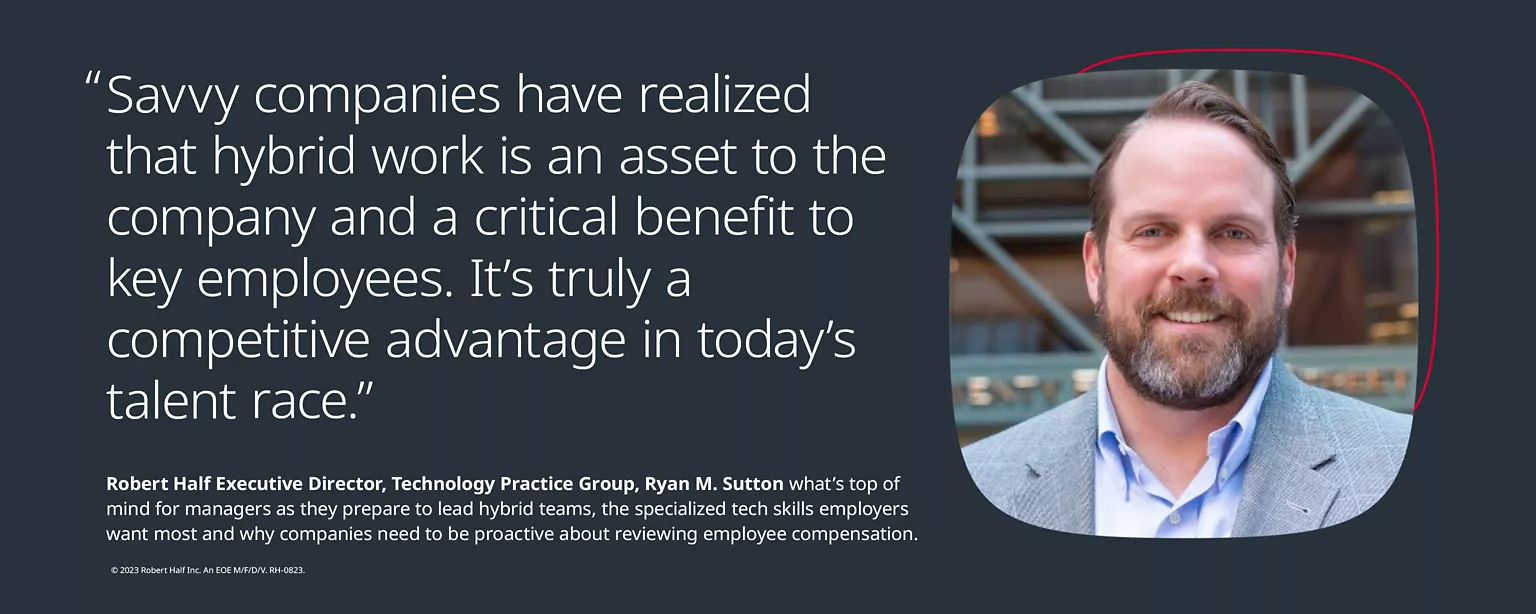Welcome to the latest post in Robert Half’s Thought Leader Q&A series, which features insights from those who have made our company a great place to work and a premier provider of talent solutions.
In this post, we feature Ryan M. Sutton, executive director of Robert Half’s technology practice group. The group specializes in helping employers connect with highly skilled technology professionals to meet their IT hiring needs. Prior to this role, Ryan was a district president at Robert Half, responsible for leading our technology talent solutions practice in New York City and New England.
Ryan is based in Boston, but before the recent pandemic, he says he “spent pretty much every waking minute, Monday through Friday, in New York City.” But today, he’s fine with Massachusetts being his center of operations: The native Ohioan moved to the greater Boston area more than 40 years ago and considers himself a true New Englander.
Ryan attended Saint Michael’s College in Vermont, where he earned a Bachelor of Science in accounting while playing NCAA sports and serving as a class government leader along the way. When he graduated and was looking for a job in the 1990s, his mother suggested that he reach out to Robert Half.
“Robert Half offered crucial career support to my mother throughout her finance career,” Ryan explains. “They helped her locate several key positions over the years — most notably, in the late 1980s, after she was laid off during the savings and loan (S&L) crisis. Robert Half placed her at a leading Boston financial institution where she led a ‘recall project,’ which involved reviewing and cleaning out all the defaulted S&L loans. That experience led her into corporate accounting as a credit director.”
As it turned out, Ryan’s mom was right that Robert Half could help him. “Robert Half placed me in my first corporate accounting job at a public relations firm that’s now part of IPG,” says Ryan. A few years later, in 1999, when Ryan was searching for a new accounting position, the Robert Half recruiter he met with asked if he’d be interested in a recruiting career. “I was — and the rest is history!” Ryan says.
That history includes helping Robert Half expand its management resources business, starting in 2003. “Being a public and corporate accountant by trade, it piqued my interest to focus more on the consulting side,” says Ryan.
Within a few years, Ryan was overseeing the technology, management resources, and marketing and creative groups at our company as a regional vice president. That led to the opportunity to become a district president in 2015, helping Robert Half grow its technology and marketing and creative talent solutions in New England and New York City. And then, in March 2023, Ryan was elevated to the executive director role, overseeing our technology practice group.
Here’s more of what Ryan shared with us during our interview, including what types of technology skills many employers currently need, and what key challenges companies and managers face as they adapt to a hybrid work model for the long term.
The pandemic spurred many companies to accelerate their digital transformation efforts. What impact has that had on technology hiring?
Cloud-related skills are in high demand as companies continue to pursue cloud migrations and upgrades and adopt new software and applications. The need for cybersecurity expertise is also increasing as organizations shift to the cloud. DevOps, software development and microservices development are all red-hot areas as well.
We’ve also seen a tremendous increase in the need for help desk and IT support specialists since the pandemic. That’s due partly to the remote and hybrid work trend, but aging IT is another factor. Many companies are moving to the cloud and beefing up their security, but they’re not upgrading infrastructure or devices due to costs or lingering supply chain issues. So, there’s a much higher need right now to support end users relying on older technology.
What trends are you observing in the broader hiring market?
The hiring market remains highly competitive because unemployment is low and the demand for talent far exceeds the pool of available professionals. So, companies still need to move quickly with their hiring process, or they could miss out. They should also take a proactive approach to reviewing compensation plans and starting salaries to help make sure valued employees don’t leave the organization searching for a raise or a more compelling benefits package.
What’s your vision for the future of work, looking out over the next decade?
I can tell you without hesitation that the hybrid work model is here to stay. Before the pandemic, your work life and home life really were two different things, and you had to balance both. But that “balance” was more like a seesaw, always tipping more to one end. Since the pandemic, many people have been able to keep that seesaw more balanced.
For example, speaking from my own experience, I can take my kids to school in the morning more often. I also have more time to watch them play sports and help them with their homework. So, there’s a lot more balance in my personal life. It would be a monumental shift to go back to exactly how things were before, when I was traveling so much.
My story is certainly not unique. And many smart, savvy companies have already realized that hybrid work is a way to finally give employees the opportunity to find and maintain that critical balance we’ve all been talking about for so long.
Productivity isn’t a concern in most hybrid work worlds. Companies already know their employees can be productive working remotely—the pandemic provided that. Instead, I think these are some of the top challenges many companies and managers are still grappling with in our new normal:
- Finding the right key performance indicators to measure remote and hybrid team performance
- Building a strong rapport with team members through digital platforms
- Leading remote teams confidently, comfortably and effectively
Because of those challenges, which obviously will take time to work through, I expect business leaders at all levels are weighing questions such as, “What does it mean to be an effective hybrid team leader?” and “How do I become a better one now?”
What other “silver linings” did you find during the recent pandemic, in addition to achieving a better sense of work-life balance?
Another positive thing is that our family started paying closer attention to the little stuff in our finances. Like what digital services are we paying for? We now have a great handle on that kind of spending, which can really add up, and we’re saving more money now than we did in the five years prior to the start of the pandemic.
We’ve also been making plans to travel. We’d like to see more cultural venues in Europe. For example, we’re thinking about visiting Paris because my youngest child loves city life, and I think she’d really like to see Paris.
Do you like going back into the office regularly again?
Oh, definitely. While I appreciate having more balance, I do like to maintain some separation between my work life and home life.
There’s another reason I go to the office: I want to do my part to help support local businesses. I don’t bring a lunch with me, for example — I buy food from the cafes nearby instead. I also go into the sundry store in our building regularly to buy a few small things, even though I may not need those items! I think it’s important to do this, because if these businesses don’t survive, we’re really going to miss those amenities when more of us start working at the office regularly again.
Follow Ryan M. Sutton on Twitter and LinkedIn.
Meet other Thought Leaders at Robert Half, such as Steve Saah and Robert Ziegler.






